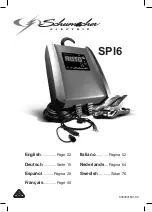
IMPORTANT SAFETY INSTRUCTIONS
I. PERSONAL PRECAUTIONS
:
1. Someone should be within range of your voice or close enough to come to your aid when you work near
a lead-acid battery.
2. Have plenty of fresh water and soap nearby in case battery acid contacts skin, clothing, or eyes.
3. Wear complete eye and clothing protection. Avoid touching your eyes while working near a battery.
4. If battery acid contacts skin or clothing, wash immediately with soap and water. If battery acid enters
the eye, immediately flood eye with cold running water for at least 10 minutes and get medical attention
immediately.
5. NEVER
smoke or allow a spark or flame in the vicinity of the battery or engine.
6. Be extra cautious to reduce the risk of dropping a metal tool onto the battery. It might spark or short-circuit
the battery or other electrical part and cause a fire or an explosion.
7. Remove personal metal items such as rings, bracelets, necklaces, and watches when working with a
lead-acid battery. A lead-acid battery, when shorted, can produce a current sufficient to weld a ring or the
like metal causing a severe burn.
8.
Use the battery charger for charging gel-cell, AGM and flooded lead-acid batteries only. Do not use the
charger for charging dry-cell batteries that are commonly used with home applications. These batteries
may burst and cause injury to persons and damage to property.
9. WARNING – RISK OF EXPLOSIVE GASES
: Working in the vicinity of a lead-acid battery is dangerous.
Batteries generate explosive gases during normal battery operation.
II. CHARGER PRECAUTIONS
:
1. NEVER
charge a frozen battery.
2. Make sure the cord is located so that it will not be stepped on, tripped over, or otherwise subjected to
damage or stress.
3.
Do not operate the charger with a damaged cord or plug; replace them immediately.
4.
Do not operate the charger if it has received a sharp blow, been dropped, or otherwise damaged.
5.
Do not disassemble the charger. Incorrect reassembly may result in a risk of electric shock and fire.
6. To reduce the risk of electric shock, disconnect the charger from the AC source before attempting any
maintenance or cleaning.
7. LOCATION OF CHARGER
: The charger should be mounted on a wall, vehicle floor, ventilated compart
-
ment or other suitable surface as close to the batteries to be charged as possible. Do not block the char
-
ger’s fan or air intakes. Do not mount the charger directly over the batteries as fumes may cause exces
-
sive corrosion. The area should be well ventilated and free from excessive moisture, exhaust manifolds,
and battery fumes. For maximum performance, the charger should not be located in an area of extreme
high temperature. The charger is not waterproof. Do not mount the charger where there is a possibility of
water entering the unit. Evidence of water entry into the charger will void the warranty.
8. CAUTION
: Do not attempt to increase battery bank capacity by splitting the output of one of the banks
with a diode-type battery isolator. The diode isolator lowers the charger voltage and results in under-
charging the batteries connected to it. If additional capacity is required it is preferable to add another
isolated or parallel battery.
III. GROUND AND AC POWER CORD CONNECTION
:
1. The charger should be grounded via the AC power connection to reduce the risk of electrical shock.
2. The charger must be plugged into or wired to an outlet that is an over-current protected 3 prong outlet.
Alternatively, it may be routed through a separate dedicated fuse or circuit breaker on an AC distribution
panel with proper earth/safety ground. All wiring shall comply with UL recommendations, NEC or NFPA
standards and local ordinances. Never alter the AC cord or plug if provided. Any modification of the cord
must only be done by a qualified electrician. Improper cord/outlet connection may result in a risk of elec
-
trical shock.
3. Observe color coding of the AC wiring as follows:
Black………....................... AC Hot or LINE (fused)
White…………................... AC Neutral
Green…….................…….. AC Ground (safety/earth)
4. CAUTION
: (230 VAC applications only): If AC input is provide from a source consisting of two HOT or
LINE leads (phase-to-phase 230 VAC input voltage); an external fuse or circuit breaker must be used to
protect both hot leads.
170 Cherry Avenue
West Sayville, NY 11796
www.kussmaul.com
Ph: 800-346-0857
Fax: 631-567-5826
2


























